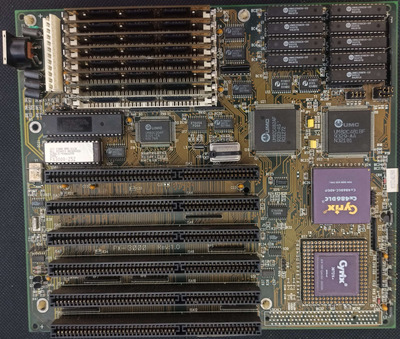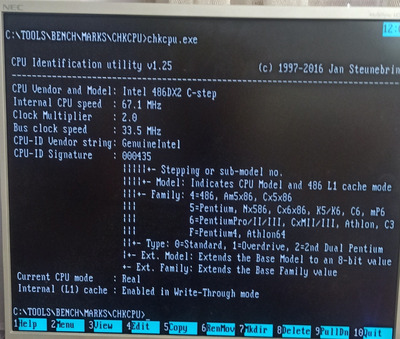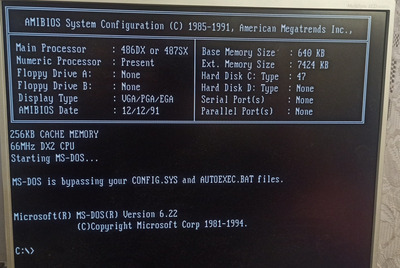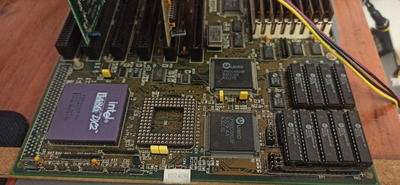I've got one of these (with the US 3486 branding) along with the manual. There might be some additional documentation in the manual not floating around already. I may be able to scan/photgraph mine for archive purposes at some point.
It's the same UMC based 3486 board I referenced a few times last year in the 'fastest 486' thread, though I have a bunch of benchmark result photos I never uploaded.
Having the crystal oscillator used for clock generation allows for unusual flexibility and custom FSB speeds, especially in 486 mode (since 386 mode requires double the osc frequency for the same CPU/bus speed). Surprisingly mine seems to run flawlessly at 66.67 MHz when using two Intel 486 DX-50s and one Intel SX-33 I have (yes the SX-33 overclocks to 200%). It tries to POST at 80 MHz, but hangs and I haven't tried anything in the 70-75 MHz range yet. I did use a 100 MHz oscillator to run 50 MHz AM386DX-40s and Cyrix and TI 486DLC-40s at 50 MHz without issue. It also does relatively well with overclocked ISA bus stuff, and with some fiddling I managed to get enough I/O wait states to get my Vibra 16s stable in most/all games while still overclocking the ISA bus for better VGA card performance. (since mine lacks the VLB header, and even if I had it, I'd be extremely surprised if I could get VLB cards running above 50 MHz)
Like the two other 3/486 hybrid boards I have (one OPTI 495SX and one Symphony chipset) and perhaps a fair number of 1990-1992 era socket 1 486 boards, it also has no issue running ST/Cyrix/IBM DX2 CPUs or DX4s even (I have 2 ST 486DX4s I've reserved for these overvolting experiments and have had no problems after many tens of hours of running them at over 120 MHz with heatsink+fan, and up to 144 MHz in this board using 48 MHz bus). Some later boards that are still too old for explicit DX4 support have issues with some or all DX4 CPUs (and 5x86s too, especially Cyrix ones), but these early boards don't seem to have the same issues, aside from overvoltage.
I have one IBM Blue Lightning DX2 that will run at 108 MHz (2x54) in this board as well. I have not rigged up an interposer of any sort to force 2x multiplier on the Cyrix/ST DX4, though, but want to at some point.
The BIOS in mine lacks an option to disable parity, so I need fast 9-bit wide SIMMs to make best use of this board. And even at normal 486 bus speeds, it's the fastest memory performance I've seen out of a 1990 era board. I had to back setting off to slower DRAM and cache timing at the high bus speeds, unsurprisingly, though the DX-50 at 1x66 MHz still had a significant advantage over the DX/2 at 2x33 I tried. (with fastest stable timings for both)
If anyone else could try their boards out with overclocked FSB speeds, that'd be really interesting to see if it's a common feature of these boards (or this chipset) or mine is just exceptional.
I'd already had success running the same two Intel DX50s and an SX33 at 60 and 66 MHz on other board prior, so I knew they could work at such speeds, but was more surprised that a 1990 dated board was capable of it ... with 30 pin SIMM RAM and parity enabled even. (I believe I got some 70 ns SIMMs working too, at slower settings at 66 MHz, but I have some 60 ns sticks that do better: I'd already sorted some of these 60 and 70s sticks during 286 and 386SX overclock testing)
It makes me wonder if higher bus speeds would've been practical/realistic in Socket 1/2/3 boards, at least using select chipsets and board designs and sacrificing VLB performance/compliance (or just supporting much higher wait states on the VLB slots to stay compatible with existing cards).
Note: my previous tests with those CPUs had been with PCI based SiS 496/497 486 boards, and they also undervolted well in those boards (stable 60 MHz at 3.48V, at least with fan cooling, but 66 MHz needed higher voltage for at least one of the DX-50s) Same for the SX-33, except I forget if 66 MHz worked with that at 3.48V ... I want to say all of them did 66 MHz at 3.6V with heatsink and fan. (though using the rated 5V didn't hurt other than make them run hotter)
I don't have a Cyrix DX-50 on hand to try out, either. I do have AMD and Cyrix DX40s I've set aside for later testing. (I've been too busy with other things the last 6-8 months)



